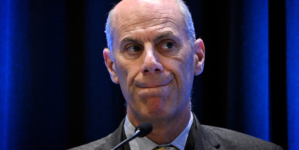-
Saquon Barkley’s Reaction to Cooper DeJean’s Shocking Nod - 11 mins ago
-
Finland’s Short, Precious Summers Are Plagued by Goose Poop - 12 mins ago
-
Dallas Wings Take Shot at Liberty Online After Shocking Upset - 46 mins ago
-
Site of Midtown Shooting Is Owned by Rudin Management and Houses NFL and Blackstone - 57 mins ago
-
Pam Bondi Files Complaint Against Judge Over Making ‘Improper’ Comments About Trump - about 1 hour ago
-
Ryne Sandberg, Hall of Fame Second Baseman for the Cubs, Dies at 65 - 2 hours ago
-
Jon Gruden Says Lions QB Jared Goff Reminds Him of Joe Montana - 2 hours ago
-
Chaos Overtakes a Midtown Block as the Work Day Comes to a Close - 2 hours ago
-
Who Was Shane Devon Tamura? Police Reportedly ID NYC Shooter - 3 hours ago
-
Eugenio Suárez Trade Sweepstakes Takes Wild Turn For Worst After Scary HBP - 3 hours ago
How a Viral Image Is Fueling the Fight over Reports of Starvation in Gaza
Photographs of a young Palestinian child appearing to suffer from severe malnutrition have emerged over the past week as a new symbol of the humanitarian crisis in the Gaza Strip, where the war between Israel and the Palestinian Hamas movement is grinding on amid repeated failed ceasefire initiatives.
But the images have also set off a firestorm of controversy, with a number of sources arguing that one-and-a-half-year-old —photographed being cradled by his mother, Hidaya—also suffered from underlying conditions contributing to his emaciated state, and that his “non-emaciated” brother was cropped out of the photos.
While few deny that Palestinians in Gaza are faced with dire and deteriorating living conditions, the debate is playing out as Israeli officials and supporters of Israel’s war aims contend that reports of mass hunger in the besieged territory are exaggerated and deliberately engineered to fit a narrative backed by Hamas.

OMAR AL-QATTAA/AFP/Getty Images
“There is no starvation in Gaza, no policy of starvation in Gaza, and I assure you that we have a commitment to achieve our war goals,” Israeli Prime Minister Benjamin Netanyahu declared on Sunday.
But as the United Nations and international humanitarian organizations argue otherwise, one of the Israeli premier’s closest allies, President Donald Trump also cast doubt on Netanyahu’s claim when asked by a reporter if he agreed with it.
“I don’t know. I mean, based on television, I would say not particularly because those children look very hungry,” Trump said Monday, adding that there is “real starvation in Gaza” and “you can’t fake that.”
A New Flashpoint
Photographs of the young Matouq first appeared in a July 23 front-page article by the Daily Express, a right-leaning British tabloid. They were quickly featured on a number of international outlets, including BBC, CNN, The Guardian, NBC News, The New York Times and The Washington Post.

NEW YORK TIMES, DAILY EXPRESS
Most coverage included Matouq’s image to reinforce reporting about the humanitarian situation in Gaza, with many including additional visuals and sources, such as local and international aid workers. Yet the majority of the articles did not reference that Matouq also suffered from other ailments, as alleged by investigative journalist Michael Collier, who is supportive of Israel’s war efforts.
In a series of X posts, Collier accused mainstream media outlets on Sunday of manipulating Matouq’s plight without highlighting that he had cerebral palsy, hypoxia and a “serious genetic disorder,” citing what he said was a May 2025 medical report issued in Gaza.
“You exploited the image of a child with cerebral palsy to push a lie about famine,” Collier wrote in a follow-up post Monday directed toward several major outlets who featured Matouq’s image. “You did this because you are all running campaigns to demonise Israel. You did not care anything about the truth. You saw an image you could use – or abuse – and ran with it.”
“In doing so, you ignored the real story: Mohammed is medically vulnerable,” Collier added. “He needs specialised formula and medication.”
Collier’s reporting was backed up by the pro-Israel monitor Honest Reporting, which further accused major news outlets of failing to reveal Matouq’s reported preexisting diseases.
“Every outlet that promoted this false narrative must update their coverage to reflect the full truth: Muhammad has a medical condition,” the organization wrote Sunday. “He is not simply a victim of starvation, and the image has been presented in a misleading and incomplete way.”
Getty Images, which hosts several photos of Matouq and his mother taken by a photographer from the Turkish news agency Anadolu, described the child as “sick” and “also displaying signs of malnutrition” in accompanying captions.
A Newsweek search of Getty’s database found numerous photos of other Palestinians, both children and adults, also displaying signs of malnutrition in recent imagery taken from Gaza.
Newsweek has reached out to Collier, the Israeli Consulate General in New York, the United Nations Office for the Coordination of Humanitarian Affairs (OCHA) and the U.N. World Food Program for comment on this story.

BASHAR TALEB/AFP/Getty Images
‘Starvation Is Widespread’
Many international humanitarian organizations, including U.N. agencies, have accused Israel of blocking a sufficient amount of aid from reaching Gaza, exacerbating desperate conditions for the territory’s approximately two million people.
The Gaza-based Palestinian Health Ministry, which is overseen by the territory’s Hamas-led government, reported Saturday that five more people had died of starvation, bringing the total number of deaths due to hunger in Gaza since the war began on October 7, 2023, to 127, including 85 children.
Israel announced in March it would block the flow of aid into Gaza, arguing that such shipments were being diverted by Hamas for the group’s benefit. Israel later authorized one organization, the U.S.-backed Gaza Humanitarian Foundation, to operate in select distribution points.
The U.N. has rejected offers to coordinate with the Gaza Humanitarian Foundation, arguing that the group’s system put Palestinian lives at risk amid repeated reports of violence emerging at aid distribution sites. Israel has accused the U.N. of failing to facilitate the entry of aid convoys into Gaza due to its lack of cooperation.
Amid growing international pressure, Israel announced last week that it would begin to allow Arab countries such as Jordan and the United Arab Emirates to resume airdropping aid packages into Gaza. The Israel Defense Forces (IDF) then announced Sunday that its forces would begin a daily “tactical pause” for humanitarian purposes in three areas: Gaza City, Deir al-Balah and Musawi.
The announcement was welcomed by U.N. agencies, including the World Food Program, which noted in its statement Sunday that “some 470,000 people are enduring famine-like conditions” and “people are dying due to a lack of humanitarian assistance.”
Tess Ingram, Middle East and North Africa spokesperson for the United Nations Children’s Fund (UNICEF), argued the situation remained critical.
“The evidence from the Gaza Strip is clear – malnutrition is rising, fast, due to the lack of food, safe water and nutrition treatments,” Ingram told Newsweek. “Starvation is widespread and it is killing people, especially children.”
She testified that colleagues in Gaza had spoken with mothers “who are watching their babies waste away in front of them, and medics who are despairing about their inability to save them.” She said UNICEF has also conducted interviews with children “who were injured in the desperate search for food, or watched a parent be killed in front of them while trying to get a little bit of aid.”
“This crisis is manmade and entirely preventable,” Ingram said. “Aid of all types must be allowed to enter the Gaza Strip at scale, immediately. UN agencies, including UNICEF, and our humanitarian partners must be able to safely collect that aid from crossings and distribute it to families in need, wherever they are.”

CARLOS REYES/AFP/Getty Images
Information Warfare
As charged narratives continue to swirl over the war in Gaza, the constant stream of visuals emerging from the conflict continue to prove influential in shaping the perceptions of observers, including officials.
Trump’s recent reference to televised footage as the basis for his skepticism over Netanyahu’s claim that starvation was non-existent in Gaza was not the first time the president has cited media coverage in his comments on the conflict.
In a March 2024 interview with the Israel Hayom newspaper, Trump asserted that “Israel made a very big mistake” in releasing footage of its offensive in Gaza.
“These photos and shots—I mean, moving shots of bombs being dropped into buildings in Gaza—and I said, ‘Oh, that’s a terrible portrait,'” Trump said at the time. “It’s a very bad picture for the world. The world is seeing this.”
W.J.T. Mitchell, a noted media theorist and professor at the University of Chicago, argued that the role of “visual images is crucial” in the information war currently raging against the backdrop of the conflict between Israel and Hamas.
“They have an immediate impact on the viewer, and make it much harder to deny what is going on,” as does “the testimony of objective observers and humanitarian workers (who are also suffering—and fainting while they work—from malnutrition),” Mitchell told Newsweek.
Mitchell also said it was important to distinguish between “misinformation, which is simply incorrect or doubtful,” and “disinformation, which is the deliberate attempt to mislead and deceive.”
“It is the essential feature of propaganda,” he added. “And then there is ‘gaslighting,’ which is the systematic attempt to confuse viewers and sow distrust in media. This strategy is effective in making people doubt what they see, or — even worse — refuse to look at the evidence because it is upsetting.”
Source link




















